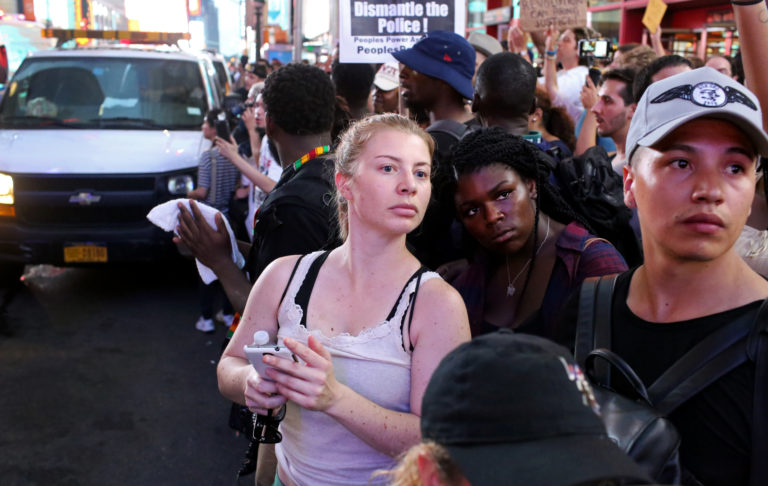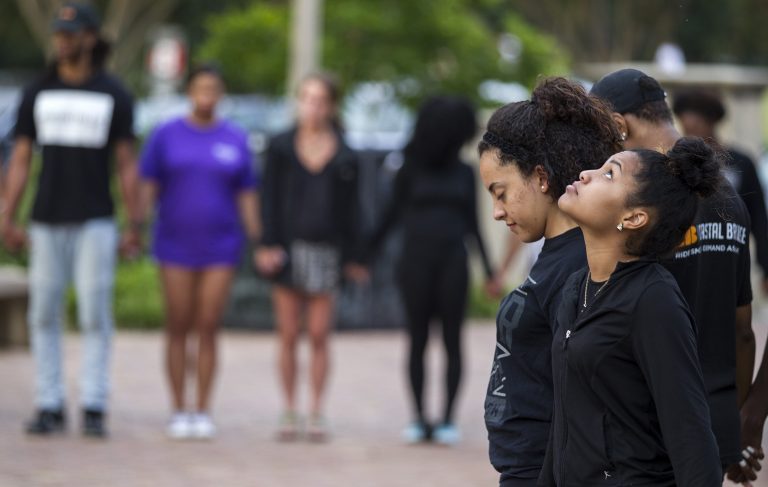
Passersby watch a Black Lives Matter protest in Times Square, New York City. Image by Yana Paskova/Getty Images, © All Rights Reserved.
Pulling Back the Veil, Together
Last week’s column inspired a lot of passionate dialogue in the comments section. At first, I struggled with some of what I found — particularly people whom I could tell were good-hearted, but seemed in denial about the existence and influence of racism in contemporary America. But the more I stayed, the more I read, the more I noticed the nuances of the dialogue between people (almost all strangers to me), the more I felt reassured. We were pulling back the veil. We were holding one another tight.
The conversations happening here and here are what America needs more of — challenging, real dialogue about our gaps in understanding, our differences of opinion and experience, particularly among white people. There were commenters, as far as I could tell, from a variety of racial and ethnic backgrounds, but it seems like most of us were white people grappling with the issues and one another.
I’m grateful to On Being for creating such a rare space in our otherwise blustering, polarized culture. It isn’t “nice,” but it is respectful. It isn’t performatively provocative, but it is frank. It’s a place where I believe people take chances to say things that they are afraid to say, myself included.
I noticed some important patterns to some of the pushback the column received, so I wanted to highlight those points and offer some reframing thoughts on each. It turns out that many of these arguments mirror the dialogue, however disjointed and cantankerous, that is happening in the wider culture, so I thought it might be helpful for people as they go out into their communities and continue to have these brave and necessary conversations.
1. What about black-on-black crime? Black people need to take responsibility for their own violence in their own communities.
It’s critical that all forms of violence be addressed in our culture. Focusing on one context for violence, in this case police shootings, doesn’t preclude also addressing violence among youth, or gender-based violence.
In fact, there are so many hardworking, deeply thoughtful people of a variety of ethnic backgrounds, black included, working on these issues day in and day out through organizations like Homeboy Industries in East LA and A Long Walk Home in Chicago, through community centers in under-resourced neighborhoods where teenagers find a place to go and compelling projects to get involved in, through domestic violence shelters, and through the continued battle to limit access to firearms in America.
Most of these efforts are vastly underfunded, so if you hear about police shootings and your attention automatically turns to the violence happening elsewhere and in other contexts, I’d say write a check and send it to one of these organizations.
2. Not all police are bad. They put their lives on the line every single day.
I actually don’t think any police officers are “bad.” I think all people have the capacity for violence within them. The more they are acculturated to see themselves as superior and see others, in particularly black and brown people, as a threat, the more their unconscious bias will collide with their access to firearms and they will make tragic decisions. There is a lot of evidence about different kinds of trainings and cultures and incentives for police officers — often called “community policing” — that leads to measurably less violence between police officers and civilians and safer communities.
There is also a critical analysis here about class, which New York Times columnist Charles Blow has offered most articulately. Police in this country are widely underpaid (some of them taking on second and third jobs to make ends meet), and therefore, even more stressed as they head out into communities that have been structurally impoverished with their own range of biases.
3. Why are you making it about race? All people are at risk when dealing with armed authority figures, like cops.
As mentioned above, I agree that the more entrenched a person is in a culture of toxic masculinity, white supremacy, and militarization, the more likely that violence will occur. It breeds an oppositional, fear-based reaction in people rather than a relational, trust-based one. But the statistics show that black and brown people are disproportionately at risk in encounters with police officers, so they are — quite rationally — more afraid when dealing with police than are white people.
Related, racism is not just about personal bias. In the words of Dr. Robin DiAngelo,
“Racism is group prejudice backed by institutional power.”
This means that while individual police officers may bring their own prejudice to heated encounters, it is also the institution and culture of policing that need reinvention. Our entire criminal justice system is built to privilege the already privileged, whether by skin color or class background. For more on the big picture, read Michelle Alexander’s The New Jim Crow, or listen to her incredible conversation with Krista Tippett. And for a really thoughtful, accessible primer on white privilege, watch this video:
4. White privilege is politically correct BS. What we really need to teach our kids is to be colorblind. All lives matter, not just black lives.
Yes, race is technically a construct, but it’s one that has guided and continues to guide our lives in powerful and sometimes deadly ways. To pretend that race hasn’t shaped the history of this country — from slavery to redlining of neighborhoods to hiring practices — is to write a revisionist history that creates a delusional present. We are not all born on the same equal playing field, no matter how much we would love that to be the case. This is what many people call equality vs. equity.
We are born into families with vastly different access to wealth and legacies of structural violence and the trauma that comes from it, among so much else.
So yes, we should teach our kids to be open to friendships with other kids of any and all races, but we shouldn’t pretend that each of those kids has the exact same lived experience or access to opportunity or safety. We disempower all children, including white children, with a false worldview when we don’t acknowledge the complexity of our history and our present.
As one thoughtful commenter points out, even the notion that one is a “white child” is a construct. He suggests using alternative language: “as someone who will be regarded as ‘white,’ you will be afforded…” I see the validity in this approach; it further delegitimizes the worldview that race is somehow a scientific point of difference, rather than a socially and historically constructed one. I also see the danger in it. Part of why racism persists is white people’s aversion to speaking plainly about their own identity (perceived or otherwise). It’s a slippery slope from “you will be perceived as white” to “I don’t really identify with being white.” Until the latter is a choice for everybody, it shouldn’t be a choice for anybody.
And, of course all lives matter. The Black Lives Matter movement isn’t pointing out the precarious nature of contemporary existence for black Americans as a way of building a hierarchy. They are, we are, boldly claiming that black lives matter as much as all other kinds of lives, and that this hasn’t been reflected in policies and practices of our country’s most revered institutions (police, among them, but also educational, financial, medical institutions etc.).
5. Why are the tactics of the Black Lives Matter so disruptive — causing inconvenience for people who have nothing to do with the police murders?
Some of the tactics used by the Black Lives Matter movement are, indeed, inconvenient for white Americans, not to mention Americans of a wide variety of ethnic backgrounds. This is intentional — a way of making people, who might otherwise not take this issue personally, confront their own complicit involvement. It also creates economic incentives for those in power to change — if transportation is interrupted, people lose money, and if people lose money, they are motivated to pay more attention to the message being communicated. It’s smart protest.
Some of the tactics used by the Black Lives Matter movement aren’t “disruptive.” Leaders of the movement are relentlessly speaking out publicly, telling stories, painting a picture of a more peaceful, just future. They are creating safe spaces where black people can take care of one another and heal. They are creating policy demands and communicating with political leaders.
These efforts — also strategic, but with different goals, and therefore different means — don’t get as much attention in the news, and therefore aren’t acknowledged as widely.
Read more about the misconceptions related to Black Lives Matter, some of which directly touch on points made in the comments section. And if you haven’t already, be sure to listen to this beautiful conversation with Black Lives Matter co-founder Patrisse Cullors and public health advocate Robert K. Ross.


Share your reflection